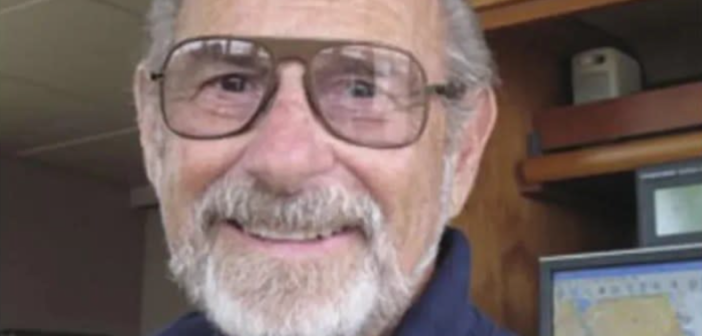Bruce Kessler, who managed to pack three overflowing lives into one, passed away on April 4 under hospice care in his home in Marina del Rey, California, just a week after his 88th birthday and wedding anniversary with Joan Freeman; they had been together for 54 years.
Kessler’s seventh floor condo was filled with memorabilia reflecting his multi-faceted life: Pictures of race cars he had driven (and crashed); posters of movies and TV shows he had directed, and maps of the 34 countries he and Joan had visited on their three-year voyage around the world. Appropriately, the condo’s terrace overlooked the harbor, filled with more than 5,000 boats. Over the years, Kessler had cruised more than 100,000 nm as the captain of his own vessels.
Kessler was born in Seattle, and took to the water almost as soon as he could walk. He started fishing from a dock on Vashon Island, in south Puget Sound. When he wanted to go out on a boat to catch more fish, his mother tied the boat to the dock with long painter and told him he could row out as far as it allowed, “but that’s as far as you can go.”
His family moved to Los Angeles when he was ten; they became successful in the ladies swimsuit business. Ever adventuresome, Kessler started driving his mother’s Jaguar XK120 in California Sports Car Club races when he was 16; he was known as “little lead foot.”
Kessler raced more and more, winning more and more, and then helped design a Scarab aluminum car with a 5-liter Chevy engine to compete with the European cars. When he started building it, his parents were skeptical. “If this is such a good idea, why isn’t General Motors doing it?” his father asked.
But Kessler won the Sebring Grand Prix in 1958, and the Riverside Grand Prix driving a Scarab, (beating world champion driver Phil Hill in a Ferrari), and then Porsche invited him to drive at the 24-hour race in Le Mans. In the middle of a rainy night at Le Mans, he ran in to a wrecked car and crashed. He was in the hospital for a while. Back in California, he had another crash a year later in a Pomona race, and was in a coma for several days. He stopped racing, but he remained friends with fellow race car aficionados James Dean and Steve McQueen.

Kessler made his debut as a director with a 19-minute documentary, The Sound of Speed, about Scarab race cars. It ran at the Cannes Film Festival in 1962 and got him a job as an advisor for racing and chase scenes in action movies. Kessler became an understudy for Howard Hawks, himself an amateur race car driver, and worked on Red Line, a 1965 movie about stock cars starring James Caan.
Over the years, Kessler directed The Monkees, It Takes a Thief, The Rockford Files, Marcus Welby, MD, and MacGuyver, plus the car chase scene in Bonnie & Clyde, among many more.
Life as a Hollywood director gave him time off, and Kessler returned to his first love, fishing. He bought a series of ever-larger boats, often heading down to Cabo San Lucas at the tip of the Baja peninsula in Mexico.
Wanting a design of his own, Kessler worked with naval architect Steve Seaton and Delta Marine, which had been making only commercial boats, to build a groundbreaking full-displacement offshore cruiser, which Kessler whimsically named Zopilote, after a Mexican turkey buzzard. It was launched near Seattle in 1985.
The Kesslers cruised the west coast in Zopilote and in 1990 they took it down to the Great Barrier Reef in Australia for fishing. They had not planned on going around the world, but when they were given a high price to ship the boat back to California, they decided to just keep going. They ended up back in Fort Lauderdale in 1993, achieving a measure of fame in the blue-water cruising community. In fact, Zopilote was only the sixth recreational powerboat to achieve a circumnavigation.
A year later, Zopilote came to a tragic end. Kessler had just wrapped a season of shooting The Commish, and was cruising on Prince William Sound when Zopilote hit an uncharted seamount at Dixon Entrance, about 70 miles west of Ketchikan, Alaska. The boat sank quickly, but all four people on board were rescued quickly from a life raft.
Three years later, Kessler, again joining with Steve Seaton, built The Spirit of Zopilote (pictured), a 62-footer, at Northern Marine, and then cruised from Alaska to Maine and many ports in between. The Kesslers ended up keeping it in Southwest Harbor, Maine, because they loved cruising in that part of the world.
Kessler was friends with Jim Leishman, the vice president of Nordhavn, and worked on filming the Nordhavn Atlantic Rally from Fort Lauderdale to Gibraltar in 2004. The day after we landed in Gibraltar, I had breakfast with Bruce and Joan and asked them if they missed being on one of the boats for the crossing. They both laughed. “I think we’ve done that,” Kessler said. (Kessler’s documentary of the rally, Living the Dream, has been viewed 714,000 times on You Tube; for its part, Nordhavn ordered 10,000 copies of the DVD.)
In 2007, Kessler started the FUBAR cruise of 53 powerboats from San Diego to La Paz, Mexico. Under a new name, the rally continues to this day.
A little while later, I presented Kessler with something akin to a lifetime achievement award at the Miami boat show. After I read a summary of his bio, he came to the podium and said, “Jeez, I’ve forgotten that I’ve done half of that.”
In his later years, Kessler had coffee most mornings with his fishing buddies at the Marina del Rey Starbucks. Bruce Kessler always liked being around people who did things.
You can see Kessler’s first film here:




